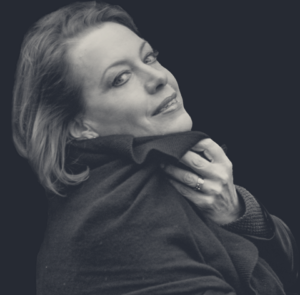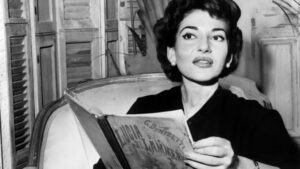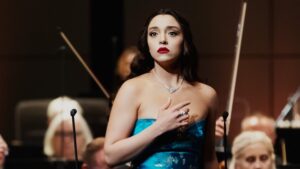If the director’s staging jettisons the narrative’s maritime aspects, Tcherniakov’s intelligent character direction proves so compelling that he ultimately retains the work’s riveting elemental nature. While his treatment of Wagner’s redemption-through-love motif takes an unexpected turn, the continuity of Tcherniakov’s storytelling and the fascinating questions it poses to the audience solidify this as one of the most outstanding productions of Der Fliegende Höllander in recent memory.
Tcherniakov and his dramaturge Tatiana Werestchagina portrays the Höllander as a deeply disturbed individual scarred by childhood trauma. As the curtain rises to the overture, he stages the character “H’s” backstory to motivate the revenge arc he would later traverse against his society. The curtain rises to reveal a woman and a child walking the streets of a charming Nordic town, its sterile, monochromatic aesthetic and its residents’ equally homogeneous color palette (expertly coordinated by costume designer Elena Zaytseva) evoking the unsettling Calvinistic ambiance of Michael Haneke’s The White Ribbon.
The child observes his mother entering an affair with an older man who would later be revealed as Daland. After a brief time lapse, Daland is observed rejecting H’s mother and throwing her on the ground. The town’s residents cruelly ostracize the woman who was refused entry by a church where she attempted to take refuge. H tragically witnesses his mother’s suicide through hanging, clutching her body as the overture draws to a close.
Act I ensues after an even more significant time lapse, and H is now revealed as an adult lurking by the entrance of a bar frequented by Daland and the town’s men. H slowly edges towards the group and takes his place at the end of an elongated communal table, offering gifts of tobacco and alcohol to the barflies. When the Steuermann slips into a drunken slumber, H regales the crowd with the mystical backstory of his great monologue—the character’s calculating cunning and his vengeful intentions masterfully drawn out by Tomasz Konieczny to complement Tcherniakov’s reading of the character.
Diverging from the libretto’s emphasis on the supernatural, H’s enigma unfolds through a Nordic Noir-esque prism that explores his masterplan and the deep psychological scars that motivate his reemergence. Most importantly, the tale unfolds as a social inquiry into the moral codes and the hypocrisy that underpin this community, and how these societal traumas reflect into and corrupt the leading characters’ trajectories. Ultimately, H’s plans are set into motion when, enticed by the promise of untold riches, Daland agrees on arranging H and Senta’s marriage.
Tcherniakov engages the opera’s second act with even greater artistic liberties that contribute to his storytelling’s unique angle. In place of the libretto’s spinning routine, Tcherniakov stages the congregation of the townswomen as a choral rehearsal led by Mary, elevated in this production to the role of Daland’s life partner and potentially, Senta’s mother. Amid the sartorial unanimity of olives, beiges, and sundry earthtones, Senta immediately sticks out, her yellow coat and her hot pink highlights marking her as something of a rebellious freethinker.

But Senta’s non-conformist streak transcends the superficial in Tcherniakov’s treatment, and with this unique portrayal aligns her more closely with Wagner’s ideal of the “woman of the future”—the Ortrud and Isolde archetypes that would define his later heroines. In her mockery of Mary’s conducting of the spinning song, she conveys a thinly veiled critique of the mundanity of her milieu’s chosen lifestyle. By callously dismissing Erik’s romantic overtures, she offers a clear rejection of her society’s expectations of marriage and domesticity. Most crucially, Senta’s defiant demeanor during her singing of the ballad expresses her desire to achieve independent womanhood instead of the libretto’s idealization of romantic love.
When Senta and H finally meet in Daland’s dining room, a palpable unease permeates the atmosphere. Rather than depicting Senta as immediately enraptured by the stranger during their hypnotic duet “Wie aus der Ferne…,” the production distinctly conveys her initial apprehension towards the Dutchman’s mesmerizing aura before succumbing to his charms—perhaps reflecting her vacillation between her desire for true independence and her subservience to a marriage orchestrated by her avaricious father.
The Dutchman’s sincerity too is called into question—does H genuinely believe that Senta represents his path to redemption, or is he conning her in his pursuit of vengeance? Throughout dinner, Mary appears visibly unsettled by the stranger as he fixes his gaze upon her daughter. Aware of Daland’s past infidelities and the pervasive hypocrisy that plagues their town’s culture, perhaps Mary fears that Senta too is destined to suffer the same fate of disillusionment and entrapment that she herself has endured.
Tcherniakov skillfully unifies his story’s various threads into the finale when H finally unleashes his revenge upon the town. As Act III begins, H joins his crew of blue-suited, thuggish henchmen as they indiscriminately slaughter the townsfolk and set the buildings on fire. Witnessing the carnage, Senta finds herself incapable of reconciling H’s psychologically twisted nature with her commitment to escaping her community through marriage.
In desperation, Senta attempts to reach H and proclaim her fidelity, only for the Dutchman to rebuff her advances and throw her onto the floor—mirroring Daland’s actions to his mother during the prologue. When the score reaches the climactic moment upon which Senta hurls herself off a cliff, Mary emerges and shoots the Dutchman in the back, redeeming her daughter from H’s trap of cyclical trauma. Before the curtain closes, the shellshocked Senta experiences a fleeting moment of hysterical laughter before finally comforting Mary in an embrace.
In this production, Tcherniakov’s outsiders must confront their grievances against their community in their path to personal liberation. Both characters accomplish this to varying degrees—the Dutchman exacts his revenge against the townsfolk, whereas Senta through H briefly glimpses her possibility of escape from her suffocating small-town existence. However, the Dutchman’s unresolved childhood trauma ultimately traps him within a self-perpetuating cycle of violence, his moment of triumph cut short when Mary ends his life.
Senta, though herself experiencing trauma by bearing witness to the Dutchman’s brutal murders, is ultimately granted redemption and true liberation through Mary’s intervention. As this story concludes, Senta finds herself standing at a crossroads, emancipated from the devastation of her hometown and the warped destiny that consumed the Dutchman. While her fate remains uncertain, Senta ultimately becomes an independent woman freed from constraints in Tcherniakov’s compelling retelling of the Dutchman’s tale.
Tcherniakov’s intelligent direction was complemented by a cast of singing actors keen to match his exacting vision of the work. Tomasz Konieczny, who sang the role both in New York and Chicago last year and substituted for an indisposed Michael Volle during the performance of August 8, was simply riveting and authoritative in his vengeful presentation of the Dutchman. If he yields to Volle in tonal refulgence and Lied-like finesse, Konieczny’s robust and steely timbre suited the presentation of H as a figure haunted by his psychological scars. Elemental in his narration of his backstory, cunning and seductive in persuading Daland and his family, and deeply disturbing by the opera’s end, Konieczny adeptly fit this production’s manipulative and criminal personification.
Elisabeth Teige’s insouciant teenage Senta proved a more congenial fit for her soprano than Elisabeth in Tannhäuser, capturing the full palette of emotion required of Tcherniakov’s approach to her character. Teige’s plummy instrument impresses with her confident ascents to her powerful high register, but occasionally her longer phrases revealed her vocal technique’s inconsistent breath support. Georg Zeppenfeld’s musicianship and inimitable verbal fluency were balms to the ears, his word painting illustrating Daland’s unattractive traits and his personal weaknesses.

If Nadine Weissman’s earthy contralto has slightly diminished in its lustrous qualities, she was a consistently nuanced and subtle actress who capably drew attention to Mary’s more outsized part in this staging. Eric Cutler, who also sang alongside Konieczny in 2023, dramatically made his lovelorn namesake character his own. His youthful heldentenor was consistently secure, focused, and ardent throughout the character’s difficultly written set pieces. Matthew Newlin, who played smaller roles in Tristan and Parsifal during the 2024 festival, projected a beautiful lyric tenor that rang sweetly within the acoustic of the Festspielhaus.
Oksana Lyniv’s urgent direction of the Bayreuth Festival Orchestra thrilled for its evocation of the music’s surging soundscapes, her pacing swift and fluid, her sense of the drama attuned to her singers’ interpretations. In their navigation of the score, Lyniv and her musicians underlined the story’s turbulent nature and the desolation that underpins the Dutchman’s existence. However, this dynamism often compromised the score’s richly textured bass line, creating strange balances with the brass section that left various moments thin in tonal weight, and at times resulting in scrappy wind execution. Despite these minor reservations, Bayreuth’s strong musical ensemble and Tcherniakov’s team created engaging theater in a production that will undoubtedly leave its mark on Festival history.
Photos (featuring Volle): Enrico Nawrath






Comments